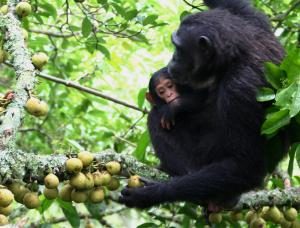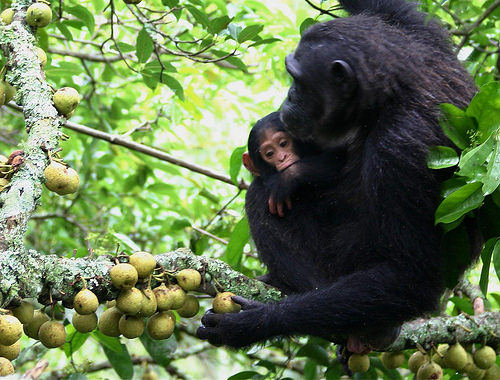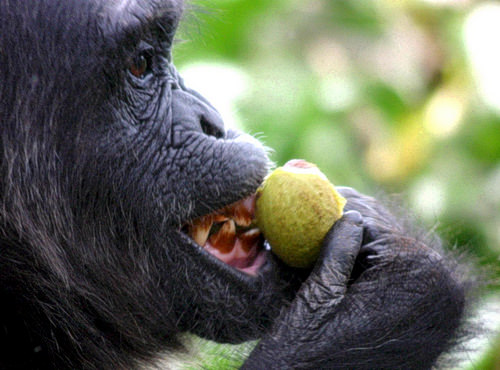
DARTMOUTH COLLEGE—Chimpanzees use manipulative dexterity to evaluate and select figs, a vital resource when preferred foods are scarce, according to a new Dartmouth-led study just published by Interface Focus. The action resembles that of humans shopping for fruits, and the study demonstrates the foraging advantages of opposable fingers and careful manual prehension, or the act of grasping an object with precision. The findings shed new light on the ecological origins of hands with fine motor control, a trait that enabled our early human ancestors to manufacture and use stone tools. (A pdf of the study is available upon request. The paper will be available for free via open access once the embargo lifts, as the link is not currently live).
“The supreme dexterity of the human hand is unsurpassed among mammals, a fact that is often linked to early tool use,” said lead author Nathaniel J. Dominy, professor of anthropology and adjunct professor of biological sciences at Dartmouth. “A problem is that we know little about the selective pressures that favored the advanced manual skills of chimpanzees and other apes. These skills were the cognitive foundation for the origin of our extraordinary hands, a trait that made all the difference.”
For the study, Dominy and his colleagues observed the foraging behaviors of chimpanzees, black-and-white colobus monkeys, red colobus monkeys and red-tailed monkeys in Kibale National Park, Uganda. The primates depended on figs, and although ripe figs come in a range of colors, many stay green throughout development and every phase can be present on a single tree, making it difficult to discern solely by color, which figs are ripe. To determine if the green figs of Ficus sansibarica are edible, chimpanzees ascend trees and make a series of sensory assessments– they may look at the fig’s color, smell the fig, manually palpate or touch each fig (using the volar pad of the thumb and lateral side of the index finger) to assess the fruit’s elasticity and/or bite the fig to determine the stiffness of the fruit. Colobus monkeys do not have thumbs and evaluate the ripeness of figs by using their front teeth.
__________________________________________
A chimpanzee in Kibale National Park, Uganda, initiates a series of sensory assessments to evaluate the edibility of figs. Sensory assessment entailed manual palpation to discern softness (elastic deformation). Photo by Alain Houle.
__________________________________________
A chimpanzee in Kibale National Park, Uganda, initiates a series of sensory assessments to evaluate the edibility of figs. Sensory assessment entailed incisor evaluation to discern toughness (chewability). Photo by Alain Houle.
_________________________________________
The team examined the spectral, chemical and mechanical properties of figs, which included boring into individual figs to assess the elasticity of the fruit and extracting fig contents to estimate nutritional rewards such as sugar. They observed the non-selection, rejection and ingestion of individual figs, and collected specimens of figs that were: avoided; palpated and rejected; palpated, bitten and rejected; and edible for which less than 50 percent of the fruit was left. Chimpanzees also use their sense of smell to assess individual figs; however, the study was unequipped to capture olfactory volatiles. Based on the sensory data obtained, the team estimated the predictive power that sensory information may have on chimpanzees when estimating the ripeness of figs.
Palpating figs was about four times faster than detaching and then biting the fruit, suggesting that chimpanzees may have a substantial foraging advantage over birds and monkeys, which rely on visual and oral information. The study provides new insight into how chimpanzees exhibit advanced visuomotor control during the foraging process and more broadly, on the evolution of skilled forelimb movements.
Source: Dartmouth College news release.
_______________________________________________________

______________________________________________
Travel and learn with Far Horizons.
____________________________________________
This richly illustrated issue includes the following stories: Recent findings shedding new light on the whereabouts of the remains of Philip of Macedon, father of Alexander the Great; how an archaeologist-sculptor is bringing bones of the dead back to life; archaeologists uncovering town life at the dawn of civilization; an exclusive interview with internationally acclaimed archaeologist James M. Adovasio about what makes the Meadowcroft Rockshelter prominent in the ongoing search for the first Americans; what archaeologists are finding at the site of the ancient city of Gath, the home town of the biblical Philistine giant, Goliath; and how scientists are redrawing the picture of human evolution in Europe. Find it on Amazon.com.










